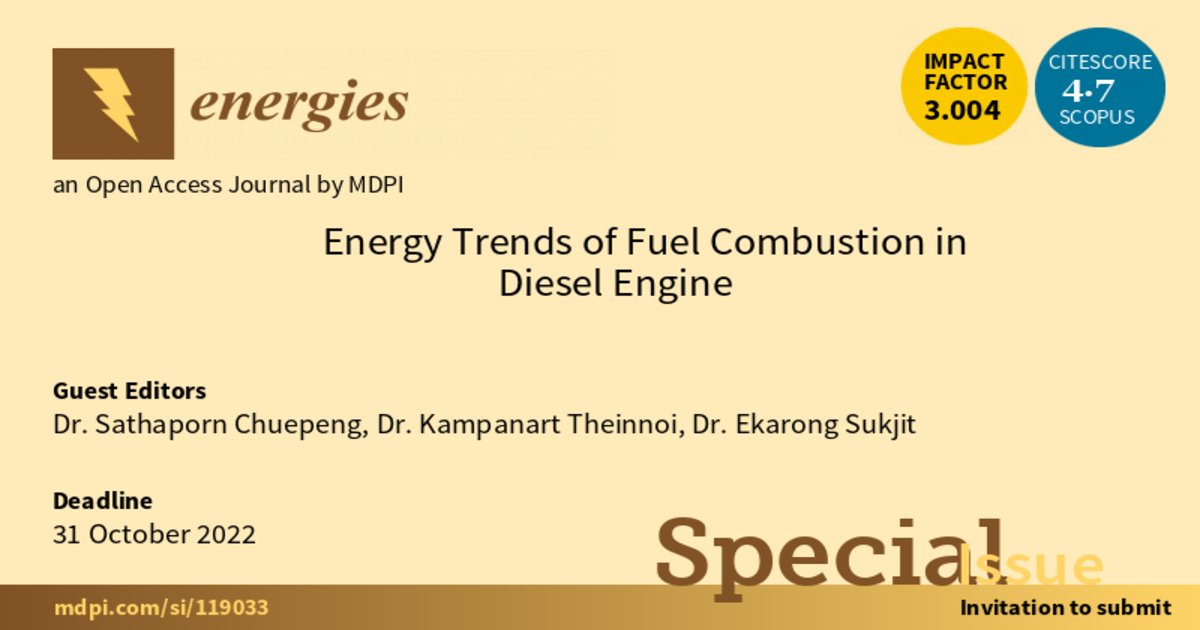Energy Trends of Fuel Combustion in Diesel Engine
A special issue of Energies (ISSN 1996-1073). This special issue belongs to the section "I1: Fuel".
Deadline for manuscript submissions: closed (31 October 2022) | Viewed by 12230

Special Issue Editors
Interests: fuel combustion; diesel engine
Interests: internal combustion engines; environmental catalysts; aftertreatment technology; fuel reforming; nonthermal plasma for emission control; combustion and emissions control; exhaust gas emissions speciation
Special Issue Information
Dear Colleagues,
Diesel engines have been progressively developed in various aspects, i.e., fuel formulation, combustion technique, after-treatment system, etc. All approaches aim to enhance fuel combustion efficiency while conforming to global emission standards. Many sources of energy have been tried and used as fuels in diesel engines using various combustion strategies.
This Special Issue entitled “Energy Trends of Fuel Combustion in Diesel Engine” aims to present and distribute the recent advances and propose the technological trends related to the theory and application of all types of energy fuels in diesel engines.
Research papers and review articles are welcome to publish in this Special Issue. The scope of topics of interest for publication include, but are not limited to:
- Alternative and advanced fuels
- Fuel energy management
- Modeling fuel injection and sprays
- Experimental fuel injection and sprays
- Multi-dimensional engine modeling
- Combustion and flow diagnostics
- Engine management and control
- Diesel HCCI, RCCI, PCCI, or other advanced CDC combustion
- Combustion in gaseous-fueled engines
- Abnormal combustion and cyclic variation
- After-treatment technology
- Emission control modeling
- Emissions measurement and testing
- Diesel particulate matter related emissions
- Low temperature catalytic combustion
- New diesel engine technology concepts
Dr. Sathaporn Chuepeng
Dr. Kampanart Theinnoi
Dr. Ekarong Sukjit
Guest Editors
Manuscript Submission Information
Manuscripts should be submitted online at www.mdpi.com by registering and logging in to this website. Once you are registered, click here to go to the submission form. Manuscripts can be submitted until the deadline. All submissions that pass pre-check are peer-reviewed. Accepted papers will be published continuously in the journal (as soon as accepted) and will be listed together on the special issue website. Research articles, review articles as well as short communications are invited. For planned papers, a title and short abstract (about 100 words) can be sent to the Editorial Office for announcement on this website.
Submitted manuscripts should not have been published previously, nor be under consideration for publication elsewhere (except conference proceedings papers). All manuscripts are thoroughly refereed through a single-blind peer-review process. A guide for authors and other relevant information for submission of manuscripts is available on the Instructions for Authors page. Energies is an international peer-reviewed open access semimonthly journal published by MDPI.
Please visit the Instructions for Authors page before submitting a manuscript. The Article Processing Charge (APC) for publication in this open access journal is 2600 CHF (Swiss Francs). Submitted papers should be well formatted and use good English. Authors may use MDPI's English editing service prior to publication or during author revisions.
Keywords
- combustion
- diesel
- emission
- energy
- engine
- fuel
- spray







